📞+86 153 7530 2641 📧 hongjing.Wang@feichuncables.com

High Voltage Shore Connection Cable SHORE POWER (N)TSCGEW11Y 6/10 kV for Cruise Liners | Halogen-Free Reeling Cable
Discover the SHORE POWER (N)TSCGEW11Y 6/10 kV halogen-free reeling cable for High Voltage Shore Connection (HVSC) systems. Designed for safe, reliable shore power to container vessels, cruise liners, and mobile carrier systems. Learn about its features, specifications, and applications.
hongjing.Wang@Feichun
8/6/202512 min read

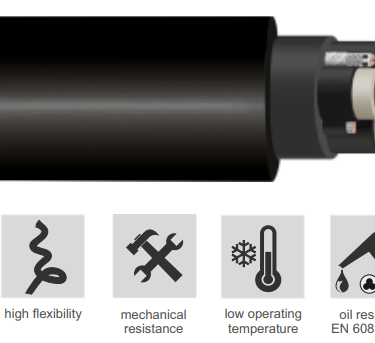
Introduction
Overview of SHORE POWER (N)TSCGEW11Y 6/10 kV Cable
The maritime industry's ongoing commitment to environmental sustainability has driven significant advancements in shore power technology, with High Voltage Shore Connection (HVSC) systems becoming increasingly vital for modern port operations. The SHORE POWER (N)TSCGEW11Y 6/10 kV cable represents a cutting-edge solution specifically engineered to meet the demanding requirements of maritime shore power applications, combining advanced materials science with robust engineering design.
This halogen-free reeling cable is meticulously designed according to IEC/ISO/IEEE 80005-1 standards, ensuring seamless integration with international HVSC systems. The cable's sophisticated construction incorporates tinned copper conductors with triple-extruded EPR insulation, providing exceptional electrical performance whilst maintaining the mechanical flexibility essential for reeling operations in harsh marine environments.
Importance of High Voltage Shore Connection (HVSC) Cables in Maritime Operations
High Voltage Shore Connection systems have revolutionised the way vessels connect to shore-based electrical grids whilst berthed, significantly reducing emissions and noise pollution in port areas. The SHORE POWER (N)TSCGEW11Y 6/10 kV cable serves as the critical link between shore-based electrical infrastructure and vessel systems, enabling ships to shut down their auxiliary engines and rely on clean grid power for onboard operations.
The environmental benefits of HVSC systems are substantial, with studies indicating potential reductions of up to 95% in greenhouse gas emissions and virtually eliminating local air pollutants such as nitrogen oxides and particulate matter. This cable technology supports ports worldwide in meeting increasingly stringent environmental regulations whilst providing vessels with reliable, cost-effective power solutions during berthing periods.
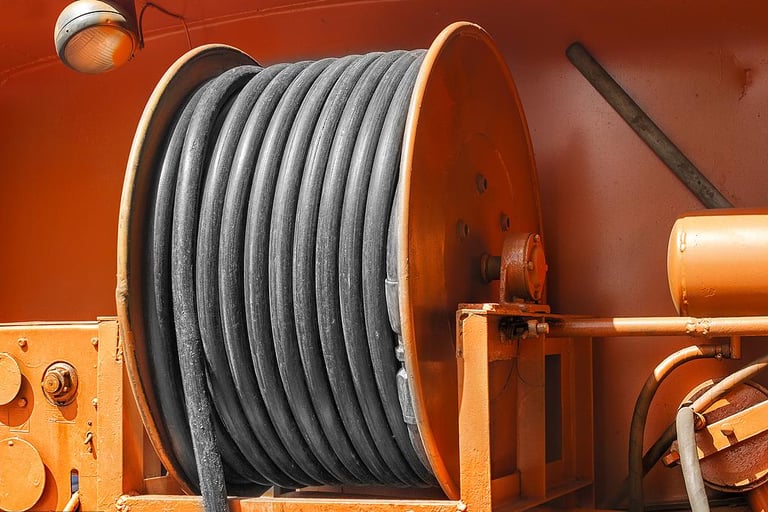

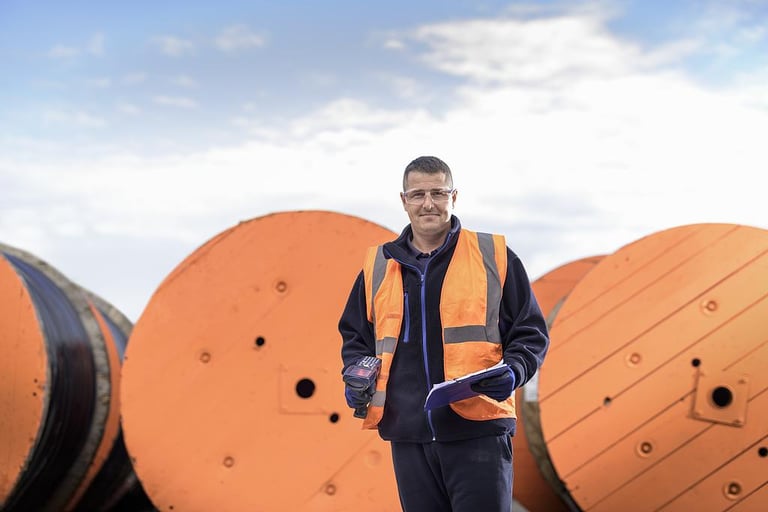

Key Features and Benefits
Halogen-Free Reeling Cable Design
The SHORE POWER (N)TSCGEW11Y 6/10 kV cable's halogen-free construction represents a significant advancement in marine cable technology, addressing both environmental and safety concerns. The absence of halogenated compounds eliminates the risk of toxic gas generation during fire incidents, creating a safer working environment for port personnel and vessel crews. This design philosophy aligns with the industry's broader commitment to sustainable practices whilst ensuring compliance with the most stringent maritime safety standards.
The cable's reeling capability is engineered to withstand the mechanical stresses associated with frequent deployment and retrieval operations. The carefully calculated conductor arrangement around a central support element, combined with the ground conductor and screened pilot cores positioned strategically in the interstices, ensures optimal load distribution during reeling operations. This configuration minimises stress concentration points that could otherwise lead to premature cable failure.
Compliance with RoHS 2015, LVD 2014/35/EU, CPR 863/EU
Regulatory compliance forms the cornerstone of the SHORE POWER (N)TSCGEW11Y 6/10 kV cable's design philosophy. The cable fully complies with RoHS 2015 (Restriction of Hazardous Substances) directive, ensuring the elimination of harmful substances such as lead, mercury, cadmium, and hexavalent chromium from the manufacturing process. This compliance demonstrates the manufacturer's commitment to environmental responsibility and worker safety throughout the product lifecycle.
The Low Voltage Directive (LVD) 2014/35/EU compliance ensures that all electrical safety aspects meet European Union standards, providing confidence in the cable's performance under normal operating conditions and fault scenarios. Additionally, Construction Products Regulation (CPR) 863/EU compliance addresses fire safety requirements, ensuring the cable's behaviour in fire conditions meets the highest standards for construction products used in buildings and civil engineering works.
Double-Layer TPU Sheath: Wear, Abrasion, and Tear Resistance
The cable's double-layer sheath system represents a sophisticated approach to mechanical protection, with the outer thermoplastic polyurethane (TPU) layer engineered according to EN 50363-10-2 standards. This TPU formulation provides exceptional resistance to wear, abrasion, and tearing forces commonly encountered in marine environments. The high tensile strength characteristics ensure the cable maintains its integrity even under extreme mechanical stress conditions.
The inner thermoplastic sheath provides additional protection against moisture ingress and chemical exposure, creating a dual-barrier system that significantly extends the cable's operational lifespan. The black colour option (with other colours available upon request) includes inkjet marking for easy identification and traceability, essential features for maintenance and inspection procedures in busy port environments.
Resistant to Oil, Ozone, UV, Moisture, and Submersion up to 10 bar
The SHORE POWER (N)TSCGEW11Y 6/10 kV cable's environmental resistance capabilities set new standards for marine cable performance. Oil resistance, certified according to DIN EN/IEC 60811-404, ensures reliable operation in environments where hydraulic fluids, lubricants, and fuel oils may be present. This characteristic is particularly crucial for container vessel operations where cargo handling equipment creates oil-contaminated environments.
UV resistance enables unrestricted outdoor use without degradation of the cable's mechanical or electrical properties, essential for installations exposed to intense solar radiation in tropical ports. The cable's ability to operate whilst completely submerged under pressures up to 10 bar (protection class AD8) provides exceptional versatility for installations where temporary submersion may occur due to tidal variations or extreme weather conditions.
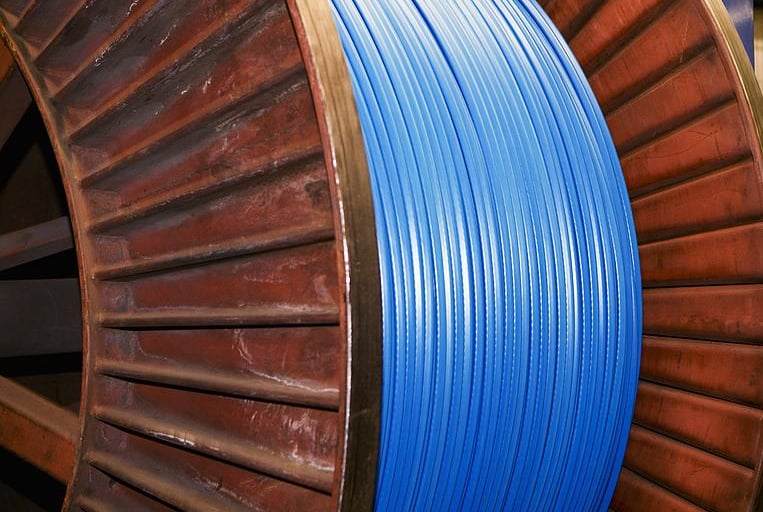

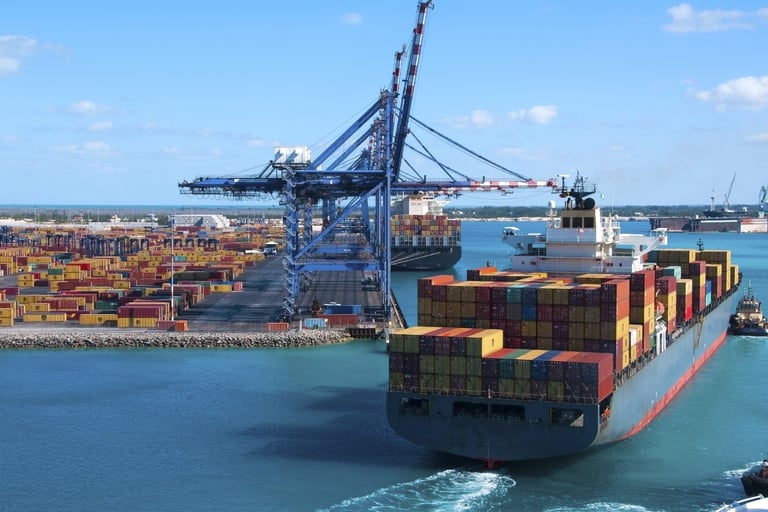

Technical Specifications
Voltage Ratings and Test Voltages
The electrical performance characteristics of the SHORE POWER (N)TSCGEW11Y 6/10 kV cable are precisely engineered to meet the demanding requirements of high-voltage shore power applications. The rated voltage U₀/U of 6/10 kV provides the foundation for safe, reliable power transmission, with the voltage rating carefully selected to match standard HVSC system requirements whilst providing adequate safety margins.
The maximum permissible operating voltage for AC systems reaches 12.5 kV, whilst DC systems can operate at voltages up to 9/18 kV, providing flexibility for various shore power configurations. The AC test voltage of 21 kV demonstrates the cable's ability to withstand electrical stress far exceeding normal operating conditions, ensuring long-term reliability and safety in service.
These voltage ratings align with international standards for HVSC systems, enabling seamless integration with existing port infrastructure whilst providing the electrical performance necessary for efficient power transmission to large vessels with substantial electrical loads.
Conductor and Insulation Details
The conductor system employs tinned copper wires manufactured to IEC 60228 Class 5 specifications, providing the optimal balance between electrical conductivity and mechanical flexibility required for reeling applications. The fine stranding ensures excellent flexibility whilst the tin coating provides enhanced corrosion resistance in marine environments, significantly extending the conductor's operational lifespan.
The triple-extruded insulation system represents advanced cable technology, incorporating an inner semi-conductive stress control layer that ensures uniform electric field distribution around the conductor. The central EPR (Ethylene Propylene Rubber) compound, formulated according to IEC 60092-360, provides exceptional electrical and mechanical characteristics specifically optimised for marine applications.
The outer semi-conductive insulation shield layer completes the insulation system, providing controlled electric field termination and enhanced safety margins. This sophisticated insulation design ensures reliable performance under the challenging conditions encountered in marine shore power applications, including temperature variations, mechanical stress, and environmental contamination.
Mechanical and Thermal Parameters
The thermal performance characteristics of the SHORE POWER (N)TSCGEW11Y 6/10 kV cable are engineered to accommodate the extreme temperature variations encountered in global maritime operations. For fixed installations, the ambient temperature range extends from -40°C to 90°C, whilst reeling operations are specified for temperatures between -30°C and 90°C, ensuring reliable performance across diverse climatic conditions.
The maximum permissible conductor temperature of 90°C provides optimal current-carrying capacity whilst maintaining safety margins, with short-circuit conditions accommodated up to 200°C conductor temperature. These thermal characteristics ensure the cable can handle both normal operational loads and fault conditions without compromising safety or reliability.
Mechanical parameters include a maximum tensile load of 25 N/mm² per conductor, providing exceptional strength for handling operations. The bending radius specifications vary according to installation type: fixed installations require 6 times the cable diameter, free movement applications require 10 times the diameter, whilst reeling applications accommodate 12 times the cable diameter, ensuring mechanical integrity across all operational scenarios.
Pilot Cores and Optical Fiber
The cable incorporates eight screened pilot cores with EPR insulation, twisted around a central filler and individually colour-coded with white insulation bearing black numerals 1 through 8. These pilot cores provide essential control and monitoring capabilities for HVSC systems, enabling remote monitoring of system status, fault detection, and automated control functions critical for safe shore power operations.
The integrated optical fiber element comprises 12 fibers manufactured to G62.5/125 OM1 specifications according to IEC 60793-2-10, providing high-bandwidth communication capabilities essential for modern HVSC systems. The multimode fiber design, compliant with ITU-T G.651 standards, ensures compatibility with standard marine communication systems whilst providing excellent signal integrity.
Typical attenuation values of 3.5 dB/km at 850 nm and 1.5 dB/km at 1300 nm wavelengths provide exceptional signal quality over typical shore power cable lengths. The ANSI/TIA/EIA 598-A colour coding system ensures easy identification and termination of individual fibers, simplifying installation and maintenance procedures.
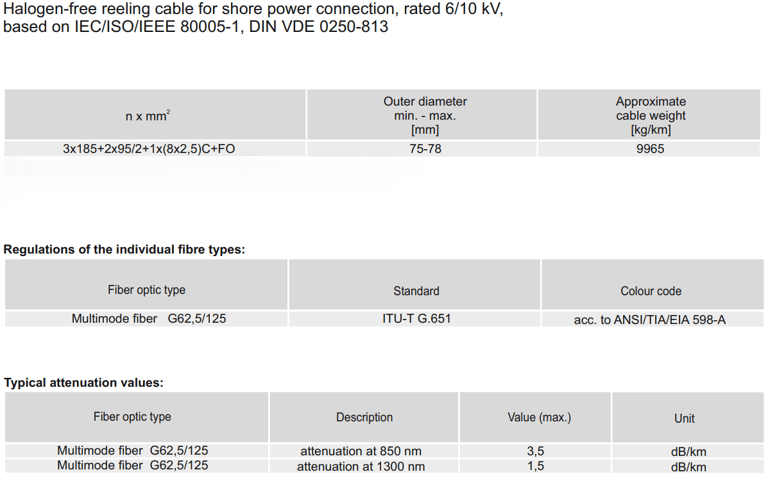

Applications in Maritime Shore Power
Container Vessels and Single-Operator Cable Cranes
Container vessel operations represent one of the most demanding applications for shore power systems, with large vessels requiring substantial electrical loads for cargo handling equipment, refrigerated container systems, and ship's services. The SHORE POWER (N)TSCGEW11Y 6/10 kV cable is specifically engineered to meet these demanding requirements, providing reliable power transmission for vessels with electrical loads ranging from several hundred kilowatts to multiple megawatts.
Single-operator cable crane systems benefit significantly from the cable's advanced design, with the integrated pilot cores providing essential control signals for automated positioning and load monitoring. The cable's exceptional flexibility ensures smooth operation during crane movements whilst the robust construction withstands the mechanical stresses associated with frequent positioning operations.
The environmental benefits for container terminals are particularly significant, with shore power enabling the elimination of auxiliary engine operations during cargo handling. This results in dramatic reductions in local air pollution, noise levels, and greenhouse gas emissions, supporting ports in meeting environmental regulations whilst improving working conditions for terminal personnel.
Mobile Carrier Systems for Cruise Liners
Cruise liner applications present unique challenges due to the vessels' large electrical loads and the need for reliable power during passenger operations. The SHORE POWER (N)TSCGEW11Y 6/10 kV cable's high voltage rating and substantial current-carrying capacity make it ideally suited for these applications, supporting the complex electrical systems required for passenger comfort, safety, and entertainment systems.
Mobile carrier systems enable flexible positioning of shore power connections to accommodate different vessel configurations and berth layouts. The cable's exceptional reeling characteristics and mechanical durability ensure reliable operation despite frequent deployment and retrieval cycles associated with cruise terminal operations.
The passenger experience benefits significantly from shore power implementation, with reduced noise and vibration levels creating a more pleasant environment. Additionally, the elimination of visible emissions enhances the environmental profile of cruise operations, supporting the industry's sustainability initiatives.
Berth-Side Grid Connection and Environmental Benefits
Berth-side grid connections enabled by the SHORE POWER (N)TSCGEW11Y 6/10 kV cable provide vessels with access to clean grid electricity, supporting global efforts to reduce maritime emissions. The cable's high voltage rating enables efficient power transmission over extended distances, allowing flexible positioning of shore-side electrical infrastructure whilst minimising voltage drop and power losses.
Environmental benefits extend beyond emission reductions to include noise pollution mitigation, with shore power enabling the shutdown of auxiliary engines that would otherwise operate continuously during berthing periods. This creates quieter port environments, improving working conditions and reducing community impact, particularly important for urban ports with residential areas nearby.
The integration of renewable energy sources into shore power systems is facilitated by the cable's advanced design, supporting ports' transition to sustainable energy systems. The optical fiber communication capabilities enable sophisticated load management and grid integration, optimising energy efficiency and supporting smart grid initiatives.
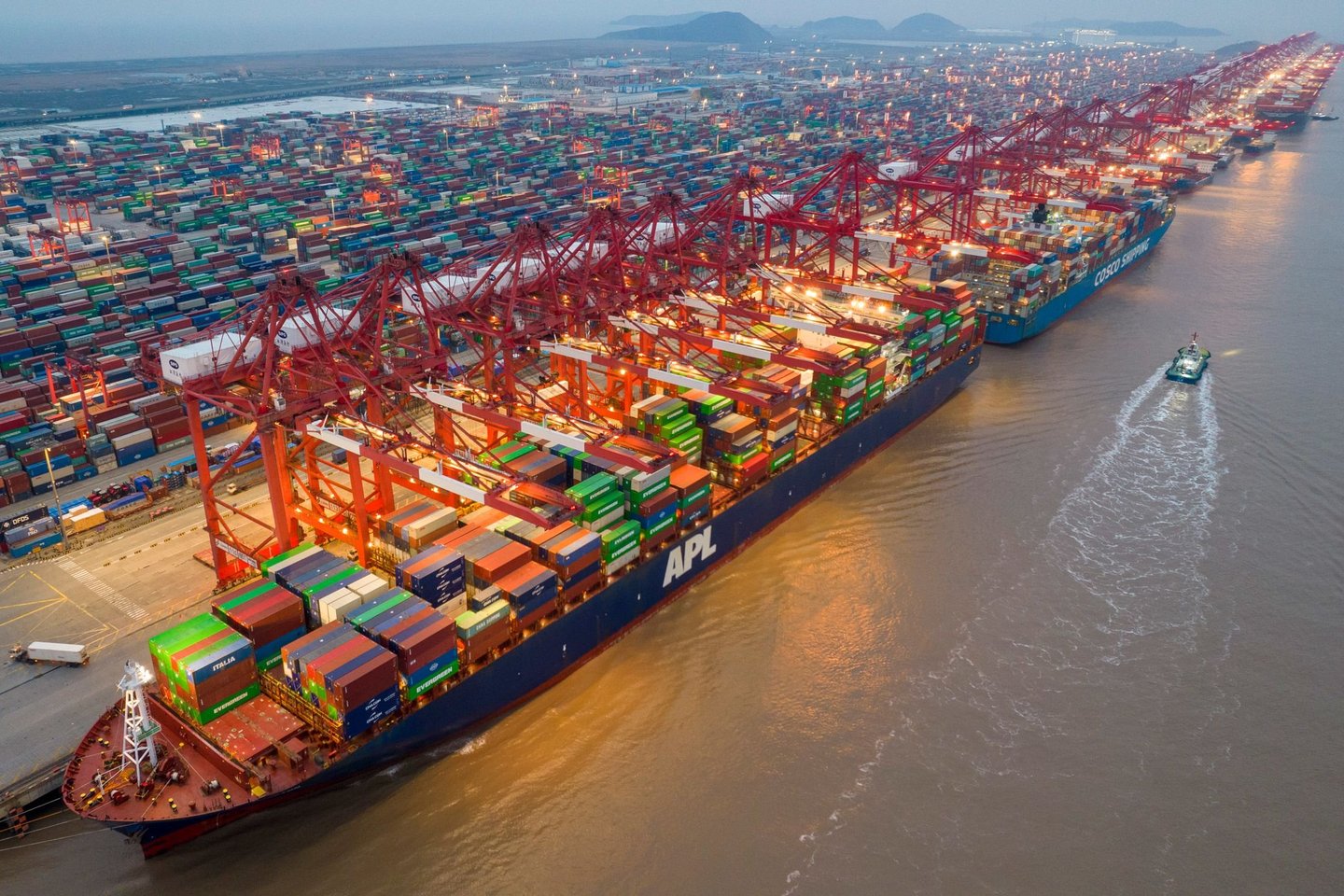

Installation and Handling Guidelines
Fixed vs. Reeling Installation Practices
Installation practices for the SHORE POWER (N)TSCGEW11Y 6/10 kV cable vary significantly between fixed and reeling applications, with each requiring specific procedures to ensure optimal performance and longevity. Fixed installations benefit from the cable's ability to operate in ambient temperatures ranging from -40°C to 90°C, whilst the reduced bending radius requirement of 6 times the cable diameter enables compact installation configurations.
Reeling installations require careful attention to the 12 times cable diameter bending radius to prevent mechanical stress concentration during operation. The cable's construction with conductors arranged around a central support element ensures optimal load distribution during reeling cycles, minimising wear and extending operational life.
Proper cable support systems are essential for both installation types, with fixed installations requiring appropriate cable trays or conduit systems to prevent mechanical damage, whilst reeling systems need precision-engineered drum and guide systems to ensure smooth operation throughout the cable's operational life.
Maintenance and Inspection Recommendations
Regular maintenance and inspection procedures are crucial for ensuring the continued reliability and safety of SHORE POWER (N)TSCGEW11Y 6/10 kV cable installations. Visual inspections should focus on the TPU outer sheath, checking for signs of abrasion, cuts, or other mechanical damage that could compromise the cable's integrity. The inkjet marking system facilitates easy identification during inspection procedures.
Electrical testing protocols should include insulation resistance measurements, conducted according to relevant IEC standards, with results documented for trend analysis. The integrated optical fiber elements require specialised testing equipment to verify signal integrity and attenuation characteristics, ensuring communication system reliability.
Mechanical inspections for reeling installations should focus on cable drum condition, guide system alignment, and any signs of stress concentration during operation. The pilot core continuity and insulation should be verified regularly, as these systems provide critical monitoring and control functions for HVSC operations.
Customisation Options: Cross-Sections and Fiber Count
The SHORE POWER (N)TSCGEW11Y 6/10 kV cable offers extensive customisation options to meet specific application requirements, with alternative cross-sections available to match different current-carrying requirements and vessel loads. The manufacturer's capability to modify fiber optic element specifications enables optimisation for specific communication system requirements.
Standard configuration includes 3×185+2×95/2 main conductors with ground conductors, eight pilot cores, and a 12-fiber optical element, but alternative arrangements can be produced to customer specifications. This flexibility ensures optimal performance for diverse HVSC system architectures whilst maintaining the cable's fundamental design advantages.
The ability to specify different numbers of pilot cores enables customisation for various control and monitoring system requirements, whilst optical fiber count modifications support different bandwidth and redundancy requirements for communication systems.
Frequently Asked Questions
Q: What makes this cable suitable for submersion applications?
A: The SHORE POWER (N)TSCGEW11Y 6/10 kV cable features protection class AD8 rating, enabling operation whilst completely submerged under pressures up to 10 bar. The double-layer TPU sheath system provides exceptional moisture resistance, whilst the halogen-free construction ensures environmental safety even under extreme conditions.
Q: How does the cable handle thermal cycling in extreme climates?
A: The cable's EPR insulation compound and TPU sheath are specifically formulated to accommodate thermal cycling between -40°C and 90°C for fixed installations, or -30°C to 90°C for reeling operations. The materials maintain their electrical and mechanical properties throughout these temperature ranges, ensuring reliable performance in diverse climatic conditions.
Q: What happens if the optical fiber element is damaged during operation?
A: The 12-fiber optical element is protected within the cable's core structure and can typically continue operation even if individual fibers are damaged. The multimode design provides redundancy for critical communication functions, and the manufacturer offers repair services for damaged fiber elements when necessary.
Q: Can the cable be used for DC shore power systems?
A: Yes, the cable is rated for DC operation up to 9/18 kV, making it suitable for both AC and DC shore power systems. This versatility enables use with various HVSC system architectures, including those incorporating energy storage systems or DC distribution networks.
Why Choose SHORE POWER (N)TSCGEW11Y 6/10 kV for your HVSC System
Selecting the SHORE POWER (N)TSCGEW11Y 6/10 kV cable for HVSC applications provides access to cutting-edge cable technology specifically engineered for marine shore power requirements. The combination of advanced materials, sophisticated design, and comprehensive support services creates a solution that meets both current requirements and future expansion needs.
The cable's compliance with international standards ensures seamless integration with existing and planned HVSC systems, whilst the customisation options enable optimisation for specific application requirements. This flexibility, combined with proven reliability and comprehensive warranty coverage, makes the SHORE POWER (N)TSCGEW11Y 6/10 kV cable the ideal choice for ports and vessel operators committed to sustainable, efficient shore power operations.
Investment in this advanced cable technology supports the maritime industry's transition to cleaner, more sustainable operations whilst providing the reliability and performance required for critical shore power applications. The environmental benefits, operational advantages, and long-term cost effectiveness make this cable an essential component of modern HVSC systems.

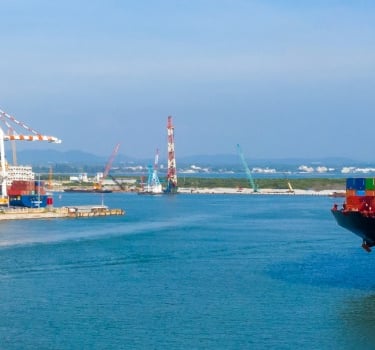
Conclusion
Summary of Advantages
The SHORE POWER (N)TSCGEW11Y 6/10 kV cable represents a significant advancement in marine shore power technology, combining environmental responsibility with exceptional technical performance. The halogen-free construction, advanced insulation system, and robust mechanical design create a solution ideally suited to the demanding requirements of modern HVSC applications.
Key advantages include the cable's ability to operate in extreme environmental conditions, from Arctic ports to tropical terminals, whilst maintaining consistent electrical performance. The integrated optical fiber communication system and screened pilot cores provide essential monitoring and control capabilities, supporting the sophisticated automation systems required for safe, efficient shore power operations.
The manufacturer's commitment to quality ensures customers receive maximum value from their investment whilst minimising operational risk.
How to Reach Us
Get in Touch
SiteMap
Product Catalogue
Reeling Cable
Festoon Cable
Shore Power Cable




Scan to add us on WeChat
